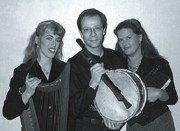ALBA
ALBA was formed in connection with the first Copenhagen Early Music Festival in 1992 and the Spanish exhibition at the art museum Louisiana the same year. Thus, a Danish professional medieval ensemble was born.
 From the first years ALBA has focused on the task of mediating the music of the Middle Ages in such a way that it can captivate the modern audience as an art form, not just a historic curiosity. By examining surviving original sources of both writings and visual arts, and by studying the still living musical traditions with roots in medieval time, ALBA first of all searched for the timeless state of emotion, which in spite of the distinctive character of both the music and the instruments, lives in music from all times. They then flavour it with a mixture of authenticity and personal expression.
From the first years ALBA has focused on the task of mediating the music of the Middle Ages in such a way that it can captivate the modern audience as an art form, not just a historic curiosity. By examining surviving original sources of both writings and visual arts, and by studying the still living musical traditions with roots in medieval time, ALBA first of all searched for the timeless state of emotion, which in spite of the distinctive character of both the music and the instruments, lives in music from all times. They then flavour it with a mixture of authenticity and personal expression.
Much like the travelling musicians of medieval times, ALBA does not demonstrate a great variety of plausible (and implausible) instruments, but does both vary and contrast their music with a virtuous and subtile control of the innumerable possibilities of their instruments. Their programmes expose the countless colours and diversities of the Middle Ages, often with a mixture of both words and music.
ALBA can be heard as a duo with Agnethe Christensen and Poul Høxbro or as a trio in company with the singer and harpist Miriam Andersén. A concert with ALBA is an invitation to experience the refinement of the Middle Ages, with music for both body and soul.
Poul Høxbro from Denmark graduated in 1994 from the Carl Nielsen Academy of Music with recorder as his main instrument, and is now employed there as co-ordinator of the musicianship/performer course. With a background as a rock drummer and performer of Andean folk music, and several years of great interest in contemporary music - giving many first performances - he has now since 1992 chosen to use this many-faceted background to revive the in medieval time so popular instrument-combination pipe-&-tabor(s). With these old and at the same time so novel sounds he is often a guest at the modern musical scene.
Agnethe Christensen, alto, comes originally from Sweden and has her roots in both classical and folk music. She studied at the Royal Danish Academy of Music and Schola Cantorum in Basel, and has participated in a large number of solo recordings for different radio stations and for CD productions, as well as giving concerts and master classes in early music. She also appears at the opera stages performing mainly modern and baroque opera.
Miriam Andersén discovered medieval music when participating in the vocal ensemble ?Schola Gregoriana Holmiae?. Before going to Schola Cantorum in Basel, she studied calligraphy and book-binding in London, worked as a calligrapher while also gaining experience with theatre and circus. Today, Miriam Andersén works as a freelance musician with medieval ensembles, e.g. Real, Sarband, Ensemble Ferrara and Discantus, but still at her agenda are theatre and experimental music projects.
Pipe-and-tabor/psaltery: the combination one-hand flute and tabor was widespread all over Europe in medieval time, from Sweden in the north to Spain in the south. With dance, both at the castle and in the village, as mealtime music, accompanying tournaments and theatre; even with church ceremony and at the battlefield, it has been possible to hear this cunning one-man ensemble, alone or together with other instruments. The flute, played with one hand, can be found in many sizes. It has three holes and a range of nearly two octaves. From the hand or the wrist hangs a drum, striking with the drum pin on both skin and edge in accompanying rhythms. This drum may be substituted for a triangle, as seen in a town hall painting in Sienna (Italy), or with a chorus (string drum) as in a few places still in Spain and southern France; a number of strings are stretched over a resonance box, tuned with the flute and then played as a drum. Often, a musician is seen to play different- or equally-sized pipes simultaneously, which enables to also play the burden, in parallel intervals or in simple polyphony. In most places, the pipe-and-drum disappeared during the course of the 16th and 17th century, but it can still be heard today as part of the folk music tradition in both Spain and France.
Tar: Frame drums were among the most common types of percussion instruments in the same period, either with small cymbals as on the modern tambourine, or without, as seen in a fresco in Bellinge at Funen in Denmark. Here, as well as on other reproductions, the drum is held vertically and hit on the skin with the free hand. This technique, still in use throughout the Orient, enables a very varied playing and numerous sound variations and explains its great popularity all through medieval time.



